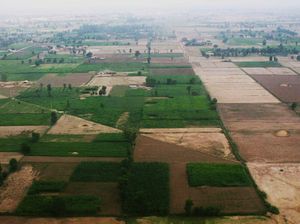The role of the agriculture sector in generating economic growth in Pakistan has been significant. This sector has, however, stagnated over the last two decades largely due to the government’s policies to support industrialization in the country as a development priority. Particularly, the last two governments have turned their focus away from agriculture and toward industry, taking away necessary financial resources and attention required for the development of the agriculture sector.
Natural disasters, floods, and droughts have compounded the problem for Pakistan. Severe flooding in September 2014 destroyed around 1 million acres of standing crops; the flooding also caused the destruction of irrigation canals and land erosion. In August 2010 floods triggered by heavy monsoon rains destroyed about 1 million hectares of crops in Punjab province. Pakistan’s principal food crops, such as wheat, sugarcane, and rice, haven’t been able to overcome the impacts of these floods: exports of rice and wheat have dropped significantly due to low production rates. To feed its own textile sector, Pakistan had to import cotton from its neighboring countries.
The rapid erosion of the vital agriculture sector is directly reflected in the country’s economic growth. Agriculture adds almost 22 percent to the country’s Gross Domestic Product (GDP); the crops mentioned above account for more than 5 percent of Pakistan’s GDP. Although Pakistan’s economy during the most recent fiscal year achieved the highest growth rate since 2008-09, it could not attain its overall set growth target of 5.7 percent, largely due to a major decline in the agriculture sector. A Pakistani think tank, Social Policy and Development Centre (SPDC), has even refuted the government’s claim of achieving 4.7 percent GDP growth for the outgoing year: “GDP growth rate is 3.1 percent, not 4.7 percent in fiscal year 2015-16,” said the institute.
The current Pakistan Muslim League Nawaz (PML-N) government is known for its excessive and often interventionist policies in the agriculture sector, particularly with regard to ignoring the needs of small farmers and imposing additional taxes in the form of increased power tariffs and fertilizer prices. Despite the military coups and changes in the government, the PML-N’s provincial government in Punjab – the most important agricultural region – has ruled the province for almost two decades; however, the growth rate of the agriculture sector has consistently lagged behind the other sectors.
Meanwhile, the government’s heavy handed approach to suppressing farmer’s demands is deeply concerning. A week ago, the Pakistan Farmer Association protested outside the Punjab provincial assembly, demanding an end to extra taxes on fertilizers and electricity. The protests were met with the government’s deployment of police. In the Okara district of Punjab province, farmers have been arrested under various anti-terrorism laws while their gatherings have been banned. “The government’s use of vague and overbroad counter-terrorism laws against protesting farmers brings new tensions to this volatile situation,” Human Rights Watch said.
These problems are primarily because of the party leadership’s fixation with the industrial sector and imbalanced economic policies that approach the agriculture sector as an “obsolete” area, which does not merit the government’s state-level growth oriented intervention. Adding to the problem is the lack of research support to increase crop productivity, outdated agricultural knowledge, erosion of the irrigation system — all resulting in lost competitiveness internationally. Although Pakistan has a predominantly agricultural economy, the rapid decline in the sector has forced Pakistan into importing a number of food commodities to fulfill its own consumption needs. Despite the marked decline, the country cannot overlook the importance of this sector: besides contributing to more than 70 percent of total export earnings, it employs almost half of the country’s labor force.
While the government has promised extra funding in next year’s budget to rescue the agriculture sector, sustained growth is impossible unless a comprehensive and modern agricultural policy is formulated.

































